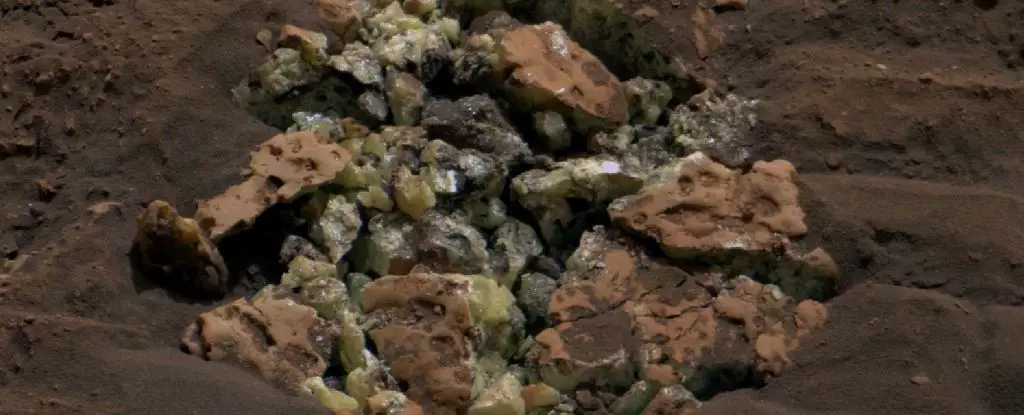In a groundbreaking discovery, NASA’s Curiosity rover unearthed something astonishing on the Martian surface—a vibrant array of yellow crystals identified as elemental sulfur. This find occurred in May when the 899-kilogram rover inadvertently cracked open a seemingly ordinary rock while navigating the Gediz Vallis Channel. While sulfate minerals have been documented on Mars, the revelation of sulfur in its pure elemental form marks a significant and unforeseen chapter in the exploration of the Red Planet.
The Gediz Vallis Channel, known for its rich geological history, showcases numerous rocks that closely resemble the one that broke open, hinting at the potential abundance of elemental sulfur in the vicinity. As Curiosity project scientist Ashwin Vasavada stated, discovering a field of pure sulfur “is like finding an oasis in the desert.” Such unexpected findings are pivotal in driving our quest for knowledge about Martian geology and the planet’s past.
Understanding the significance of sulfur extends beyond its mere presence; it is a crucial element for life as we know it. On Earth, sulfur primarily exists in the form of sulfates, which are integral for the synthesis of essential amino acids necessary for protein formation. While the recent discovery doesn’t indicate the existence of life on Mars, it underscores the presence of fundamental building blocks that could contribute to a habitable environment.
The identification of elemental sulfur enhances our understanding of Mars’s environmental history, particularly regarding its interaction with water—an essential factor in assessing the planet’s potential for past life. Sulfates typically form through the evaporation of water mixed with minerals, leaving a mineralogical signature that tells a story of the planet’s hydrological dynamics. Yet, pure sulfur’s formation under specific conditions raises questions about Mars’s atmospheric and geological evolution.
Geological Implications of the Discovery
The detection of pure sulfur in close proximity to the Gediz Vallis Channel suggests that geologists must reassess their understanding of the conditions that allowed its formation. Normally, pure sulfur arises in environments where certain volcanic or hydrothermal activities occur, processes thought to be abnormal for this particular Martian region. This anomaly reflects the broader complexities of Martian geology that still elude our current scientific models.
Curiosity’s chance encounter with the sulfur rock opens up avenues for further research aimed at understanding how this element became concentrated in its elemental state. By performing in-depth analyses on the sulfurous rocks, scientists aim to reconstruct events from Mars’s past that led to such an extraordinary phenomenon. This undertaking may involve advanced modeling of Martian geological occurrences ranging from tectonic activities to potential past volcanic events.
Access to Mars remains an intricate challenge for terrestrial researchers, given the planet’s vast distance and harsh conditions. The Curiosity rover, equipped with advanced analytical instruments, provides a unique opportunity to gather invaluable data that would otherwise remain inaccessible. However, had the rover not fortuitously traversed over this particular rock, the elemental sulfur might have remained undiscovered, highlighting the serendipitous nature of planetary exploration.
As Curiosity continues its journey across the Gediz Vallis Channel, an ancient riverbed filled with geological history, scientists anticipate unveiling further secrets of Mars. The rover recently drilled into another rock, obtaining powdered samples that may enhance our understanding of the channel’s ancient waterway and its role in Martian history. Each discovery increases the excitement surrounding the potential for more wonders beneath the Martian surface.
The discovery of elemental sulfur provokes thought about Mars’s geological narrative and potential habitability. As researchers disentangle the complex environmental interactions that allowed for such a find, we may begin to piece together the conditions that have shaped the Martian landscape over billions of years.
Future missions to Mars will continue to build on the foundation laid by Curiosity, employing advanced technologies and instruments that may reveal further geological phenomena. The journey into Mars’s past is just beginning, and with each exploration, we edge closer to unraveling the mysteries of this captivating planet, further igniting our curiosity and determination to understand not only Mars but the broader universe in which we exist.


Leave a Reply